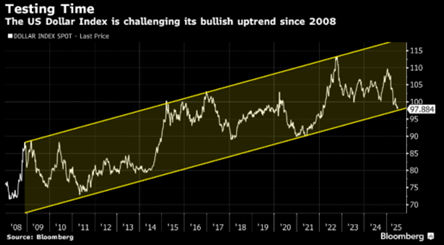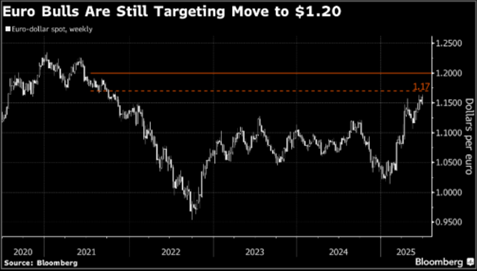Summary
- Jerome Powell testified on Capitol Hill reiterating his hawkish stance towards cuts and stressing the need for further monitoring due to economic uncertainty.
- President Trump’s decision to name a new Federal Reserve chair by late summer sparks concerns over Fed independence.
- The DXY is at 3-year lows, down 11% YTD at 97.21 due to deficit issues, further rate cut expectations and foreign currency appreciations.
- The Euro is trading at YTD highs, 1.17 as the ECB cutting cycle concludes.
- Volatility has calmed after the Israel-Iran ceasefire though there is still fear a conflict could breakout at anytime.
- The Japanese yen may experience increased strengthening as further hikes are being discussed from the BOJ.
Noteworthy
- Dollar Dives, Euro Thrives, Ceasefire Survives
Powell on the Hill
Fed Chair Jerome Powell gave his semi-annual testimony on Capitol Hill and delivered a hawkish tone. Amidst a barrage of questions from various Representatives and Senators, Jerome Powell remained adamant that his bankers were still closely determining what the full effects of President Trump’s tariff policies were; and that inflation and the labor market remain their primary focus in determining cuts. Despite reiterating his faith in the U.S. economy, he retained a cautious approach to the economy and stressed the need for diligence when approaching any rate cuts. However, there is growing speculation that Trump will name a new Fed chair as early as September or October. This could induce some volatility in FX markets as a new chair who seemingly aligns with Trump’s vision of multiple rate cuts could create a “lame-duck” remainder term for Powell as differing policy ideologies shape current and future FOMC actions.
Dollar Dives
The DXY is at 3-year lows upon Trump’s narrowing of picks for the next Fed Chair. Among the main concerns are continuing tariff uncertainty and the bickering between politicians over the U.S. deficit/big, beautiful bill. Coupled with GDP QoQ dropping -0.5% (-0.2% expected) and an overall weaker unemployment trend (initial jobless claims were better this week though at 236,000 vs 245,000 expected) the likelihood of a rate cuts has increased to a 19% chance of a cut in June and an 91% chance of a September cut. In an essay Friday morning, Fed Governor Neel Kashkari wrote that he expected two cuts. This pressure has the DXY at 97.21, down 11% year to date. The dollar is appearing dangerously close to exiting an 18-year bull run and could continue to slide over the coming months. Some of the most notable outflows in the greenback have been inflows into commodities, other currencies such as the Swiss franc, the Japanese yen, the euro, and Great British pound. Equity markets continue to rally with DAX and FTSE up 20% since April and the Nikkei up 28%. The S&P has returned roughly 24% since April and is at all-time highs.
Euro Thrives
The ECB’s Luis De Guindo in a speech this week mentioned that oil volatility stemming from the Israel-Iran conflict is leaving inflation a bit persistent but signaled that Eurozone was “very close to its target” implying there may be a door to further cuts to maintain the ECB’s goals of 2% inflation. Despite this, the Euro reached as high as 1.1744, though currently trading at 1.1722. Further U.S. rate cut expectations, continued sticky inflation, and de-dollarization, are some of the drivers behind the Euro finally breaking out of its 1.16 resistance level (it spent weeks range bound between 1.12-1.14.) The options market appears to be placing premiums on EUR/USD calls as further weakening of the dollar and subsequent strengthening of the Euro gets priced into the market. This is leading some bulls to target a new resistance level of 1.20. As the ECB draws an end to its cutting cycle and the U.S. is only just beginning look for elevated activity from the world’s most traded currency pair.
Ceasefire Survives
The Israel-Iran conflict injected a serious short-term volatility spike in world markets as oil skyrocketed and the U.S. dollar and Japanese yen rebounded. On Saturday, after the United States struck key nuclear facilities in Iran, the world tepidly waited for Iran’s response. After a brief and ineffective return of fire to a Qatari air base, Iran’s supreme leader Ayatollah Ali Khamenei claimed victory, as did Israeli Prime Minister Benjamin Netanyahu and President Trump. After slight skirmishes from both sides, a strongly worded interview from President Trump this week where he criticized both sides for fighting without cause, appears to have calmed the region and the ceasefire is still currently intact. This has stabilized oil, trading at $65 per barrel, caused gold declines and a sell-off in U.S. yields. The Shekel is trading at some of the highest levels in 2-years, trading at 3.3863, levels last seen early 2023.
Japanese Yen and Automobile Tariffs
BOJ Governor Kazuo Ueda has reopened the door of possible rate hikes after another bout of persistently high CPI data (3.1% YOY vs 3.4% the previous month). The Yen, which has appeared to be stuck in range between 140-145 since April briefly weakened to 147 from geopolitical tensions on Monday though has since recovered to its range sitting at 144.65. Japanese Trade envoy Ryosei Akazawa continues to negotiate with Washington and adamantly refuses to concede 24% tariffs on Japanese-produced automobiles. The Yen is up 8% YTD.
Contact Comerica Foreign Exchange
This publication has been prepared for general educational/informational purposes only and should not be considered as investment advice or a recommendation for any particular security, strategy or investment product, or as personalized investment advice. The information contained herein has been obtained from sources believed to be reliable, but Comerica does not represent, or guarantee, its completeness or accuracy. The views expressed herein are solely those of the author(s) at the time of publication. Comerica will not be responsible for updating any information contained within this publication, and such information is subject to change without notice. Comerica does not assume any liability for any direct, indirect or consequential losses that may result from reliance upon this publication.




